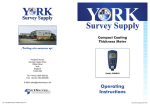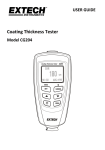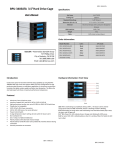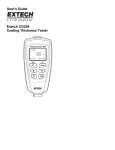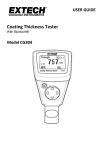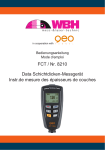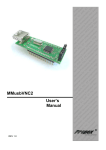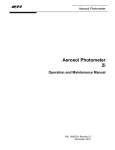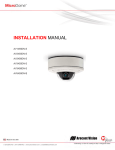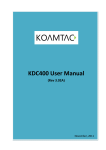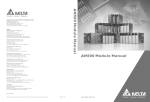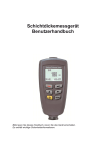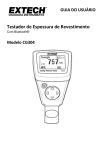Download 511 5511 002 00 Instructions
Transcript
Coating Thickness Tester User Manual Please read this manual before switching the unit on. Important safety information inside. Contenu 1.General information ............................................................................................................................. 3 1-1. Application ................................................................................................................................... 3 1-2. Description Of The Gauge ........................................................................................................... 4 l-3. Supply Schedule............................................................................................................................ 4 1-4. Probe ............................................................................................................................................ 4 1-5. Specifications ............................................................................................................................... 5 1-6.Front View .................................................................................................................................... 5 2.Preparing .............................................................................................................................................. 6 2.1. Power Supply ............................................................................................................................... 6 2·2.Replacing The Battery .................................................................................................................. 6 2-3. Menu System and Basic Settings ................................................................................................. 6 2·3·1. Menu System ........................................................................................................................ 6 2-3-2 Basic Settings......................................................................................................................... 7 3.measuring. Storage And Data Processing In Direct and Group Mode ................................................. 8 4. Calibration and Measurement ............................................................................................................. 9 4-1.General Hints for Calibration ........................................................................................................ 9 4-1-1.Calibration methods ............................................................................................................... 9 4-1-2.Storing calibration Values ................................................................................................... 10 4-1-3.calibration Example ............................................................................................................. 10 4-1-4.High-Accuracy Calibration .................................................................................................. 10 4-1-5.Cleaning the Measuring Point.............................................................................................. 10 4-2.Special Hints for calibration ....................................................................................................... 10 4-2-1.Zero-point Calibration (no need to enable calibration)........................................................ 11 4-2-2. One-point calibration .......................................................................................................... 11 4-2-3.Two-point Calibration ......................................................................................................... 12 4-2-4.Shot-blased Surfaces ............................................................................................................ 13 4-3.General Remarks on Measurement ............................................................................................. 14 5. Limit Function ................................................................................................................................... 14 6. Measurement Using Statistics ........................................................................................................... 15 6-1.Statistical Terms .......................................................................................................................... 15 6.2.Storage Capacity Overflow ......................................................................................................... 15 7.Delete Functions ................................................................................................................................. 16 8.Gauge Control Via PC ........................................................................................................................ 16 9.Trouble Shooting ................................................................................................................................ 16 1.General information The coating thickness gauges work either on the magnetic induction principle or on the eddy current principle, depending on the type of probe used. You can select the type of probe via the MENU system. The gauges conform to the following industrial standards: GB/T 4956-1985 GB/T 4957·1985 JB/T 8393·1996 JIG 889·95 JIG 818-93 Features -Measured Coatings: Non-magnetic coatings (e.g. paint, zinc) on steel; Insulating coatings (e.g. paint, anodizing coatings) on no-ferrous metals -Operating with MENU easily -Two measuring mode: CONTINUE and SINGLE mode 'Two working mode: DIRECT and GROUP mode (4 groups) 'Statistic Display: AVG. MAX. MIN. NO., S.DEV -One point calibrating and two points calibrating independently for each working mode -Zero calibrating easily • Memory for 320 reading (80 for each group) -Delete single readings and all group readings easily -High alarm and Low alarm for all working mode -Low battery, error indication -USB interface for PC analysis software -Disable Auto-Power-off function via MENU setting. 1-1. Application -This compact and handy gauge is designed for non-destructive, fast and precise coating thickness measurement. The principal applications lie in the field of corrosion protection. It is ideal for manufacturers and their customers, for offices and specialist advisers, for paint shops and electroplaters, for the chemical, automobile, shipbuilding and aircraft industries and for light and heavy engineering. • This gauge is suitable for laboratory, workshop and outdoor use. -The probe can work on both principles, magnetic induction and on the eddy current principle. One probe only is required for coating measurement both on ferrous and non-ferrous metal substrates. It is adaptable to specific tasks: i.e. they can be used on special geometries or on materials with special properties. 1-2. Description Of The Gauge - For measurement on steel substrates, the gauge work on the magnetic induction principle, for measurement on non-ferrous metal substrates, it works on the eddy current principle. -Measurement values and user information are shown on LCD. A display back light ensures easy reading of screen data in dark conditions. -Two different operating modes are available: DIRECT mode and GROUP mode. -DIRECT mode is recommended for simple, quick, occasional measurements. It provides statistical analysis. Single values are not saved. The statistical analysis program can evaluate 80 readings. -GROUP mode permits measurement and storage of readings in a free programmable memory. A maximum of 400 readings and 4 series of measurements can be analyzed according to various statistical criteria. 1-3. Supply Schedule -Gauge with two 1.SV battery, plastics carrying case, operating instructions (English), steel and aluminum substrate. -USB connecting cable -Program disc for Windows 98/2000/XP/Vista17 1-4. Probe The Probe systems are spring-mounted in the probe sleeve. This ensures safe and stable positioning of the probe and constant contact pressure. A V-groove in the sleeve of the probes facilitates reliable readings on small cylindrical parts. The hemispherical tip of the probe is made of hard and durable material. Hold the probe by the spring mounted sleeve and put on measuring object. 1-5. Specifications Sensor probe Working principle Measuring range Guaranteed tolerance (of reading) Precision Minimum curvature radius Diameter of Minimum area Basic critical thickness Working temperature Working relative humidity F Magnetic induction 0~1250µm 0~49.21mils 0~850µm (+/- 3% + 1µm) 850µm~1250µm (+/- 5%) 0~33.46 mils (+/- 3% + 0.039 mils) 33.46mils ~49.21mils (+/- 5%) 0~50µm (0.1 µm) 50µm-850µm (1µm) 850µm~1250µm (0.01mm) 0~1.968mils (0.001mils) 1.968mils~33.46mils (0.01mils) 33.46mils~49.21mils (0.1mils) 1.5mm 7mm 0.5mm 0°C~40°C (32°F~107°F) 20%~90% Size (HxDxW): 110x50x23mm / Weight: 100g 1-6.Front View 1. 2. 3. 4. 5. Probe Power ON/OFF key Zero Calibration key Down/Right key Blue key for ESC/NO/BACK function in menu mode, or backlight ON/OFF In working mode 6. Main display for coating thickness 7. Measuring unit 8. NFe: indicates readings on non-ferrous metals; Fe: indicates readings on ferrous metals 9. lndicates the probe working principle: AUTO, Magnetic induction or Eddy current 10. O-Indicates that the gauge is currently controlled via pc 11. USB connecting port 12. Low battery 13. Working mode indication: DIRECT or GROUP 14. Statistic display: AVG, MAX. MIN, SDEV 15. The statistic number of measuring readings 16. Red key for OKIYEs/ MENU! SELECT in menu mode 9 17. Up/Left key N Eddy current principle 0~1250µm 0~49.21mils 0~850µm (+/- 3% + 1.5µm) 850µm~1250µm (+/- 5%) 0~33.46 mils (+/- 3% + 0.059 mils) 33.46mils ~49.21mils (+/- 5%) 0~50µm (0.1 µm) 50µm-850µm (1µm) 850µm~1250µm (0.01mm) 0~1.968mils (0.001mils) 1.968mils~33.46mils (0.01mils) 33.46mils~49.21mils (0.1mils) 3mm 5mm 0.3mm 2.Prep paring 2.1. Po ower Sup pply For ch hecking th he battery y's state of charge e please press key: No LC C display y: Battery y missing or batterry charge e too low tto illumin nate display. D Display: gauge g sw witches offf after ab bout one second: Replace batteryy immediiately. Note tthat the gauge g willl make fa aulty mea asuremen nts if the vvoltage is veryy low. 2·2.Re eplacing The T Batte ery ·Place e the gauge upside e down o on a suita able surfa ace. -Remo ove the screws s fro om the ba attery com mpartmen nt with a cross tip screwdriver. -Raise e the lid of o the com mpartmen nt . • Rem move batte ery. -Insertt new batttery . • Close the lid and a faste en with sccrew. Cau1ion:Make sure the anode a and catho ode are co orrectly p positioned d. 2-3. Menu Systtem and Basic B Setttings 2·3·1. M Menu Syste em Press to power p on n; the gau uge will work w in me easuring mode. Press red-ba ar button into MEN NU mode e. See folllowing MENU sysstem arran nges: NOTE E: MENU system arranges a need to be known n well forr your worrks. Menu >Statisstic view > >Avera age view > >Minim mum view > >Maxim mum view w > >Numb berview > >Sdev. view >Optio ons > >Measure mode e > > >Single mode > > >Continuous mod de > > Workking mode e > > >Grroup 4 > > >Direct > >U Used prob be > > >Group 1 > > >AU UTO > > >Group 2 > > >Fe e > > >No o Fe > > >Group 3 > >Unit settings > > >um > > >mils > > >mm > > Backlight > > >ON > > >OFF > > LCD Statistic > > >Average > > >Maximum > > >Minimum > > >Sdev. > >Auto power off > > >Enable > > >Disable >Limit > >Limit settings > > >High limit > > >Low limit > >Delete limit > Delete > >Current data > >AII data > >Group data >Measurement view >Calibration > >Enable > >Disable > >Delete Zero N > >Delete Zero F 2-3-2 Basic Settings Please refer to the MENU arrange. According to the LCD indication, Press red-bar button for OK/YES/MENU/SELECT operating functions. Press blue-bar button for ESC/NO/BACK operating functions. Press the UP/DOWN button to switch the selected item. 2-3-2-1 Measure mode -Continuous measurement mode: It can sometimes be of advantage if the probe does not need to be raised between each measurement so that there is a running display of readings. In continuous mode, readings are not accompanied by a bleep. All readings taken in this mode will automatically be entered into the statistics program as long as sufficient memory is available. -Single mode: In Single mode. readings are accompanied by a bleep. Besides, Others are same as Continuous measurement mode. 2-3-2-2 Used probe The probe can work in three modes. AUTO: The probe can automatically select the working mode. When Placed on steel (magnetic substrates), it will work in magnetic induction principle. When placed on no-ferrous metals, it will work in eddy current principle. Fe: The probe works in magnetic induction principle. No-Fe: The probe works in eddy current principle. 2-3-2-3 Unit settings You can switch from Metric units (µm, mm) to imperials (mils). In “µm “ mode, the unit will switch to "mm" automatically when value of reading exceeds 850um, see the specification section for more details. 2-3-2-4 Total-Rese et A total reset errases data from al l memories. This includes all sets of o ngs of all work modes plus their ass sociated statistics, s calibratio on readin valuess and tole erance lim mits. - Switcch off gau uge. - Presss ZERO+ + sim multaneo ously. -The L LC displa ay "sure to o reset", Press red d-bar button for Y ES, or blue-bar button n for NO. -The g gauge willl restart automatic a cally. 2-3-2-5 Backlight You ca an selectt ON/OFF F in MEN U system m. Beside es, in mea asuring mode, m Press the blue--bar butto on once tto switch ON/OFF F backligh ht. 2-3-2-6 LCD Statis stic In Men nu system m mode, the statisstic displa ay can be e selected d betwee en Average, Maximum, Min nimum an nd Sdev. When re eturn to m measurem ment mode,, it will be e displaye ed on the e lower rig ght of LCD D. At the same tim me, the sta atistic number of measurin m g reading gs is disp played on n the lowe er left of LCD D. Via “sttatistic vie ew" item in MENU U system, you can look thro ough all statistic valu ues for cu urrent gro oup. 2-3-2-7 Measurem ment view Via "M Measurem ment view w" in MEN NU, you can c look through a all measu urement readings for curre ent group. 2-3-2-8 Auto powe er off You ca an disablle Auto-power-off via MENU system m or the g gauge will powerr off autom matically for abou t 3 minuttes. asuring. Storage And Datta Proces ssing In Direct a nd Group 3.mea Mode and GRO gauge offe ers two operating o modes: DIRECT D OUP mod de. This g The G GROUP mode m inclu udes GR RO 1~4. -DIRE ECT mode e is intended for q quick occa asional re eadings. In this mode, individ dual readings are logged to o memory y provisio onally. Wh hen Power off or Swiitch to GR ROUP mode, all rreadings will w be cle eaned. B ut the sta atistic valuess won't be e change ed until lo gging new measu urement rreadings. The readin ngs and statistical s he LC dissplay. The values c an be shown on th statistical analyysis program can evaluate 80 readings. When the mem mory is full, new re eadings will w replac ce old rea adings. vidual ca alibration values an nd limit va In thiss mode, itt has indiv alues. -In GR ROUP mo ode, everry group m memory can c store e a maxim mum of 80 0 single readingss, and 5 Statistic S vvalues. Calibration C n values a and limit nd stored for every y group. W When the e valuess can individually be set an memo ory is full, measuring will m ake sequ uentially, but not b be stored and statistic valuess won't be e changed d. If need d, you can n delete g group data and set calibra ate values and lim mit values . statistic valuess, and res ROUP mo ode in MENU systtem. -You ccan selecct DIRECT and GR NOTE E: in order to work in GROU UP mode, e.g. to calibrate, c adings, take rea set lim mit, the wo ord "GRO OX" mustt appear on o the LC C display,, if not, yo ou can set me easureme ent mode e in MENU U system m. -Presss wh hile holdin ng the pro obe in the e air. The e gauge w will work in DIREC CT mode e. And the e last read ding will be shown n (if availa able). asureme ent 4. Calibration and Mea 4-1.Ge eneral Hin nts for Ca alibration n 4-1-1.Calibration methods m There are four different methodss available for calibration: -Basicc calibration: recom mmended d for mea asuremen nt on eve en surface es and if the m measurin ng object has the ssame material, siz ze and cu urvature as a the zero p plate attacched in th he casing g. ended if measurin m g errors u up to ±(3% of -Zero--point calibration: recomme readin ng plus co onstant error of prrobe) are permitted. (Exam mple for constant of o probe b be error: Fe 1 um;; no-Fe 1 .5um) -One-point calibration (c calibratin g using a calibratiion foil): rrecomme ended if read dings to be b expectted will be e close to o the calib bration va alue and if the permittted errorr of probe e will be m max. ±(1% % ... 3% of o reading onstant g plus co probe error) -Two-p point calibration (u using a sset of two calibratio on foils): A) Reccommend ded for measurem m ments on rough su urfaces. B) Reccommend ded for precise m easurements on smooth s s urface if the thickness to be e expecte ed is betw ween the two calib bration foiils. 4-1-2.Storing calibration Values If the gauge is calibrated for a particular purpose, the calibration values will be stored in memory until changed. NOTE: The calibration procedure should be restarted from the beginning if: -An incorrect reading has been taken. -An incorrect command has been entered. -The gauge has been switched off. 4-1-3.calibration Example Calibration is the most important requirement for accurate measurement. The more closely the calibration sample matches the product sample, the more accurate the calibration, and therefore the reading, will be. If for instance, a product is to be measured on a steel cylinder, quality ST37(mild steel), diameter 6mm. the calibration of the uncoated sample must take place on a steel cylinder of similar quality with the same diameter. The calibration sample must correspond to the product sample in the following ways: -Curvature radius -Substrate material properties -Substrate thickness -Size of measuring area -The point at which the calibration is made on the calibration sample must always be identical with the point of measurement on the product itself, especially in the case of corners and edges of small parts. 4-1-4.High-Accuracy Calibration To achieve high-accuracy readings, it is advisable to log calibration values (both zero values and calibration foil values) several times in succession. In this way, the gauge will automatically establish a mean calibration value. For more details see 4-2 special hints for calibration. The high-accuracy calibration is an obvious advantage when calibrating on uneven, e.g. shot-blasted, surfaces. 4-1-5.Cleaning the Measuring Point Before calibration the measuring point the probe tip must be free from grease, oil, scraps of metal, etc. The slightest impurity will affect measurement and distort readings. 4-2.Special Hints for calibration The basic calibration stored in the gauge should only be used for measurements on even surfaces. i.e. on steel components made of conventional steel (mild steel) or on aluminum components. Firstly, you can turn into Calibration Mode via MENU (Menu-> Calibration->Enable) system. Then the LC will display 'Cal n(or 1~2) Zero n (or y)". The "n" means not any point calibration and Zero calibration, and '''y' means ‘there is Zero calibration", "Cal 1~2” means ''There is one or two point Calibration". After finishing all Calibration task, we advise that you disable calibration via MENU system. Preparing to make calibration: -Switch the gauge on (far from any metal at least 1 Oem). -Substrate sample and necessary foils (calibration standard). -Set woke mode: continuous or single via MENU. 4-2-1.Zero-point Calibration (no need to enable calibration) - Place the probe on uncoated sample (zero coating thickness) vertically and rapidly. -The LC display <x.x µm >. Operating is different in continuous mode and single mode. See the work mode section for more details. Then, raise the probe rapidly (far from metal substrate at least 10cm) -Press and hold Zero button for about 1.5seconds, the LC display 0.0 um. The calibration is finished. -Repeat this procedure several times. The calibration system always saves the mean value of the previous calibration point. NOTE: You can delete the old zero point calibration before making a new zero point calibration via MENU system if existent. The meter always calculates the mean of 5 calibration readings furthest. When full, the newest calibration value will replace the oldest calibration value. We suggest that you make a Zero calibration when starting a measurement. 4-2-2. One-point calibration This method is recommended for high precision measurements, measurements on small parts and on hardened and low-alloy steel. -Zero-point calibration according to section 4-2-1 -Lay the calibration foil on an uncoated sample, apply the probe and raise it if steady. Press UP or DOWN to adjust required foil thickness. The thickness of the foil should be roughly equivalent 10 the estimated coating thickness. -Repeat step 2 several times. It will get the mean value of previous calibration readings. -Now take readings by placing the probe on the coating and raise it if steady. -It may be necessary to delete calibration, e.g. after entry of a faulty calibration value: MENU->delete->delete group data (NOTE: It will delete all data, limit data, one-point and two-point calibrations except for zeropoint calibration). -This will reactivate the default basic calibration for use on even surfaces. NOTE: The meter calculates the mean of 5 calibration readings furthest. When full, the newest calibration value will replace the oldest calibration value. -Press blue-bar button to exit current calibration. Or else, after about 30 seconds, the calibration will become effective automatically. - Press Zero button to make current calibration effective compulsively. Even while a series of measurements is being taken, foil calibration can be carried out often as necessary. The old calibration will be overwritten; the Zero calibration remains in memory. 4-2-3.Two-point Calibration -Suggest that gauge is in single work mode. If necessary switch to the mode as MENU system. This method requires the use of two different foils. The thicker one should be, if possible, 1.5 times as thick as the thin one. - For best results, the thickness to be expected should be somewhere between the two calibration values. -This method is especially suitable for taking measurements on rough shot-blasted surfaces or for high-precision readings. It is advisable to take a mean for several times. This considerably reduces the effect of scattering which occurs during calibration of upper and lower values. The calibration foils may be used in any order. -Zero-point calibration according to section 4-2-1 -The first point calibration according to section 4-2-2 -Repeat the step 2. -Take readings by placing the probe on the coating to be measured and raise it after the beep. The reading is shown on display. NOTE: -Apply the probe to test sample several times. -The thickness of the foil should be roughly equivalent to the estimated coating thickness. -Even while a series of measurements is being taken, foil calibration can be carried as often as necessary. The old calibration will be overwritten; the ZERO calibration remains in memory until make the zero point calibration. -See one-point calibration for more information. 4-2-4.Shot-blased Surfaces The physical nature of shot-biased surfaces results in coating thickness reading that are too high. The mean thickness over the peaks can be determined as follows (not that the statistics program is of great benefit in this procedure): Method A: -The gauge should be calibrated according to 4-2-2 or 4-2-3. Use a smooth calibration sample with the same curvature radius and the same substrate as the later measuring sample. -Now take approx. 10 readings on the uncoated, shot-biased sample to produce the mean value Xo. -After this take approx. 10 further readings on coated, shot blasted test sample to produce the mean value Xm -The difference between the two mean values is the mean coating thickness Xeff over the peaks. The greater standard deviation s of the two values Xm and XO should also be taken into consideration: Xeff=(Xm-Xo)±S Method B: -Carry out a zero calibration of 10 readings on a shot-biased, uncoated sample. Then carry out a foil calibration on the uncoated substrate. The foil set should consist of a number of individual foils of max. 50 microns thickness each and should roughly correspond to the estimated coating thickness. -The coating thickness can be read directly from the display and should be averaged from 5 .... 10 single measurements. The statistics function is useful here. Method c: This method also gives reliable results. Simply follow the two-point calibration method using two foils as described in section 4.2.3. For a maximum approach to the respective nature of surface, the foil value can be reached by using several foils - 50um each. The mean coating thickness should be calculated from 5 ... 10 readings. The statistics program is very useful here. NOTE: For coatings thicker than 300 um, the influence of roughness generally is of no importance and it will not be necessary to apply above calibration methods. 4-3.General Remarks on Measurement -After careful calibration has been made, all subsequent measurements will lie within the guaranteed measuring tolerance. -Strong magnetic fields near generators or live rails with strong currents can affect the reading. -When using the statistics program for obtaining a mean value it is advisable to place the probe several times at a typical measuring spot. Any false readings or outliers can be removed immediately via MENU system. -The final reading derives from the statistical calculation and from the guaranteed tolerance levels of the gauge. -Coating Thickness D =X±s± µ. Example: Readings: 150 µm, 156 µm, 153 µm Mean value: X=153 µm Standard deviation: s=±3 µm Measuring uncertainty: µ=±(1% of reading + 1 µm) D =153±3±(1,53 µm +1 µm) =153±5,5 µm 5. Limit Function -Limits can be entered in DIRECT and a selected GROUP memory at any time, i.e. before, during and after a series of measurements. There is practical use for limits. -Any reading which falls outside the set tolerance limits will be registered by a warning indication: H: reading above HI limit. L: reading below W limit. Please set the limit values using MENU system. 6. Measurement Using Statistics The gauge calculates statistics from a maximum of 80 readings (GR01~GR04: in total, a maximum of 400 readings can be stored), In addition, readings can't be stored in DIR mode, but it can calculate statistics as GR01~GRQ4. When power off or changing Work Mode (see MENU system for details), the DIR statistics will be lost. The following statistical values are calculated: NO.: Number of readings in Work Mode. AVG: Average value. Sdev. : Standard deviation. MAX: Maximum reading. MIN: Minimum reading. 6-1.Statistical Terms Average value( Ẋ ) The sum of readings divided by the number of readings. Ẋ =∑x/n Standard Deviation (Sdev.) The sample standard deviation is a statistic that measures how "spread out" the sample is around the sample mean. The sample standard deviation increases with increasing spread out. The standard deviation of a set of numbers is the root mean square of the variance S2 The variance of a list is the square of the standard deviation of the list, that is, the average of the squares of the deviations of the numbers in the list from their mean divided by the(number of readings -1 ) Variance S2=∑ (x-ẋ)2/(n-1) Standard deviation S=ѴS2 NOTE: Deletion must take place immediately after an outlier or erratic reading has been taken. See the Delete function in MENU system. 6.2.Storage Capacity Overflow -In GROUP mode, if the storage capacity is exceeded, statistics will not be updated, although measurement can continue. If the memory is full, subsequent readings will omitted from the statistics. They will be marked with "FULL" in LCD (in single measuring mode). -In DIRECT mode, if the memory is full. The newest reading will replace the oldest reading. And the statistics will be updated. 7.Delete Functions In MENU system, you can find following function: - Delete current data: If you find the last measuring reading is wrong, you can delete it via this function. At the same time, the statistics will be updated. -Delete all data: You can delete all data and statistics of the Current Work Mode. -Delete Group data: this function includes -Delete all data" function. In addition, this function will delete HIGH alarm, Low alarm, and One&Two point calibrations. 8.Gauge Control Via PC All measuring readings of all work modes can be downloaded to PC via USB port for data analysis. See software guide for more details. 9.Trouble Shooting The following list of error messages explains how to identify and eliminate faults. Err1, Err2, Err3: Connecting of probe fault; Deviant signal Err1: Eddy current probe. Err2: Magnetic induction probe. Err3: Both probes. Err4, 5, 6: reserved. Err7: Thickness fault.
















